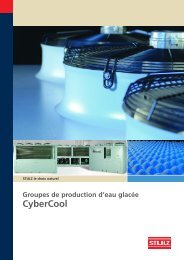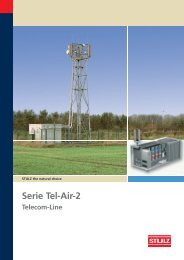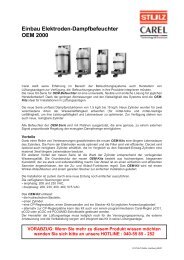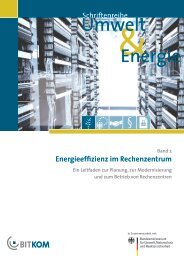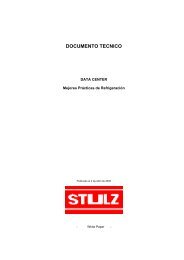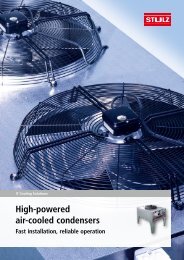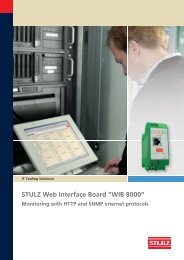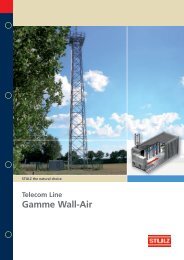Climate protection needs energy efficient data centers - Stulz GmbH
Climate protection needs energy efficient data centers - Stulz GmbH
Climate protection needs energy efficient data centers - Stulz GmbH
You also want an ePaper? Increase the reach of your titles
YUMPU automatically turns print PDFs into web optimized ePapers that Google loves.
spots in the racks for example, and the avoidance of faultsources when altering cable routing.Ideally, as much as possible of the cross-sectional area inthe underfloor plenum should be made available to theair volume flow. Unnecessary obstacles in the underfloorplenum need to be eliminated: surplus cables should beremoved and essential cabling laid in such a way that nohigh crossings occur.Special cable seals with overlapping brushes are recommendedin order to seal openings for cable assembliesand wiring as well as possible. They will guarantee a tightseal, even with very large volumes of cable.It is advisable to dimension the height of the raised flooradequately, right from the planning stage, to ensure thatthere will be no bottlenecks if changes need to be madelater on, to IT or cabling, for example.Optimal and <strong>energy</strong>-<strong>efficient</strong> cooling demands intelligentcable management and the deployment of the latest productsin the rack. Cabling must not be allowed to impedeair flow.In enclosed cabinet cooling solutions and server cabinetswith very high heat loads, cabinets may well have to beeven deeper, as additional space is required in front of andbehind the 19” installations for the transport of the veryhigh volumes of cooling air (up to 6000 cbm/h in onecabinet). For these applications there are cabinet depthsof 1300mm, 1400mm and 1500 available on the market.• 5.3 Power management5.3.1 Power management as an approachto improving <strong>energy</strong> efficiency5.2.4 Rack depth extensionPower management is absolutely essential for an <strong>energy</strong><strong>efficient</strong>,<strong>energy</strong>-optimized <strong>data</strong> center operation.Rack depth is a key specification when equipping a <strong>data</strong>center. In standard configurations of alternating hot andcold aisles rack depth is a prime determinant for the spacingof axes within the <strong>data</strong> center.Where heterogeneous server systems are operatingwithin the same rack - which is more likely to be the rulethan the exception – IT administrators must opt for adepth-variable solution. A homogenous layout is desirablefor <strong>energy</strong> efficiency reasons.There are various different HVAC systems available fortransporting heat away from the chip and out of thebuilding. They use gaseous or liquid media to do so andinclude such devices as air circulation units, cold waterunits, chillers, heat exchangers and condensers. All thesesystems need to be considered individually and thenoptimally coordinated.5.3.2 Power control in the air cycleUp until a few years ago the standard depth for serverracks was 1000mm. In recent years racks with depthsof 1070mm, 1100mm or 1200 have also come onto themarket.This can be attributed, on the one hand, to the introductionof servers with a rack mount depth in excess of thestandard 740mm, and on the other, to a demand for morespace behind the installations to accommodate cablingand PDUs.As with any technical equipment, precision coolers, too,have many different components where <strong>energy</strong> savingscan be made. The choice of fans, for example, offers greatsavings potential, for they run 24 hours a day and thus8760 hours a year. It is this consideration which has leadto the rapid breakthrough of EC (electronically commutated)fans. The power consumption of these speedcontrolledfans drops drastically when air volume flow isreduced.16



